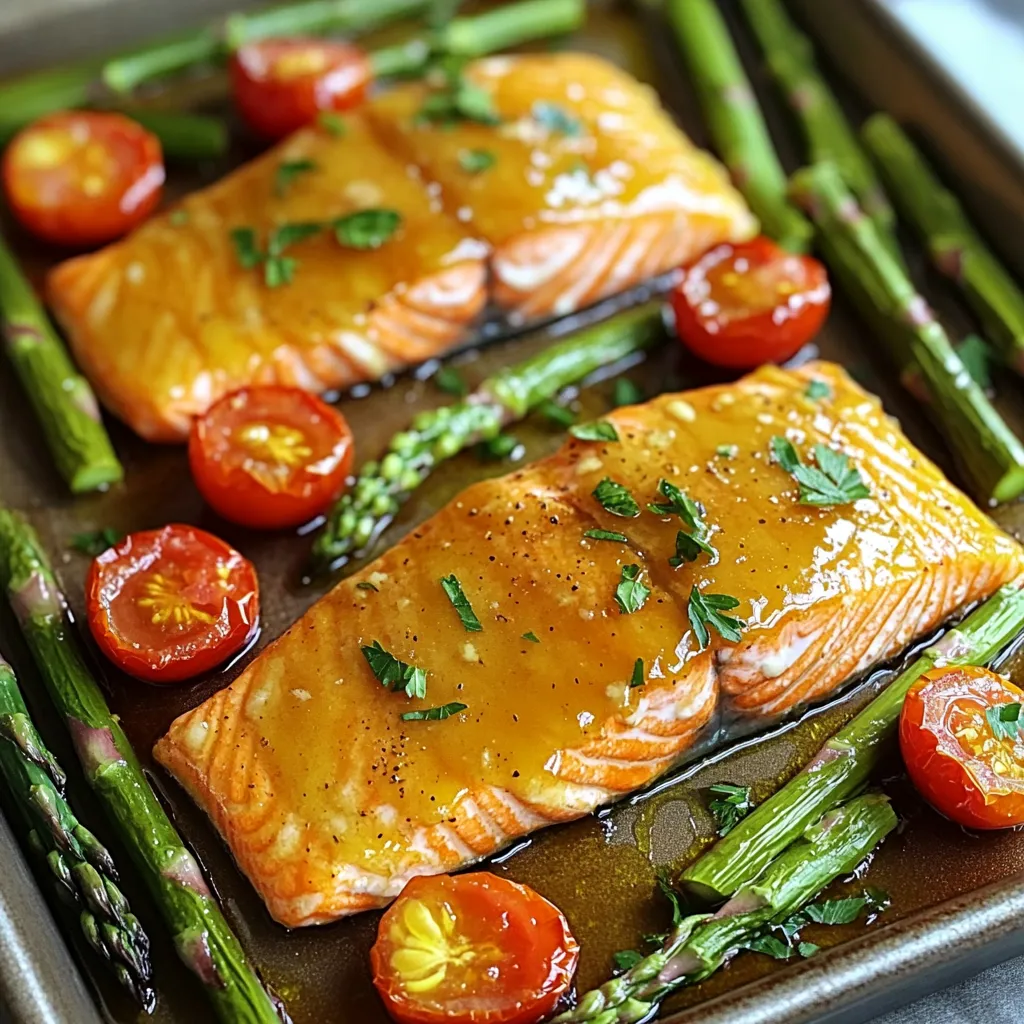
Looking for a meal that’s both fresh and packed with flavor? Maple Glazed Salmon & Veggies is a dish you need to try! With its sweet glaze and vibrant veggies, it’s sure to please your taste buds. In this post, I'll guide you through easy steps, ingredient tips, and fun variations. Get ready to impress yourself and your loved ones with this simple yet delicious recipe! Let's dive in.
Why I Love This Recipe
- Delicious Sweet and Savory Flavor: The combination of maple syrup and soy sauce creates a unique glaze that perfectly complements the richness of the salmon.
- Quick and Easy Preparation: This recipe requires minimal prep time and cooks in just 25 minutes, making it perfect for a weeknight dinner.
- Healthy and Nutritious: Packed with omega-3 fatty acids from salmon and vitamins from fresh vegetables, this dish is both wholesome and satisfying.
- Beautiful Presentation: The vibrant colors of the asparagus and cherry tomatoes alongside the glazed salmon make for an impressive and appetizing meal.
Ingredients
Complete Ingredient List
- 4 salmon fillets (about 6 oz each)
- ¼ cup pure maple syrup
- 2 tablespoons soy sauce
- 1 tablespoon Dijon mustard
- 1 tablespoon olive oil
- 2 cups asparagus, trimmed
- 2 cups cherry tomatoes, halved
- 2 cloves garlic, minced
- Salt and pepper to taste
- Fresh parsley, chopped (for garnish)
Recommended Ingredient Quality
When cooking, quality matters. Choose fresh, wild-caught salmon for the best flavor. Look for bright, firm fillets. The skin should be shiny and moist. For veggies, select vibrant asparagus and ripe cherry tomatoes. Fresh herbs, like parsley, add a nice touch. Always use pure maple syrup, not the flavored kind. It enhances the glaze’s taste.
Substitutions for Common Ingredients
You can swap salmon for another fish, like trout or cod. If you want a meatless option, try tofu instead. Use tamari if you need a gluten-free soy sauce. Dijon mustard can be replaced with whole grain mustard or honey mustard. For a lower-carb option, skip the glaze or use a sugar-free alternative. The veggies can change too. Try zucchini or bell peppers if you like.
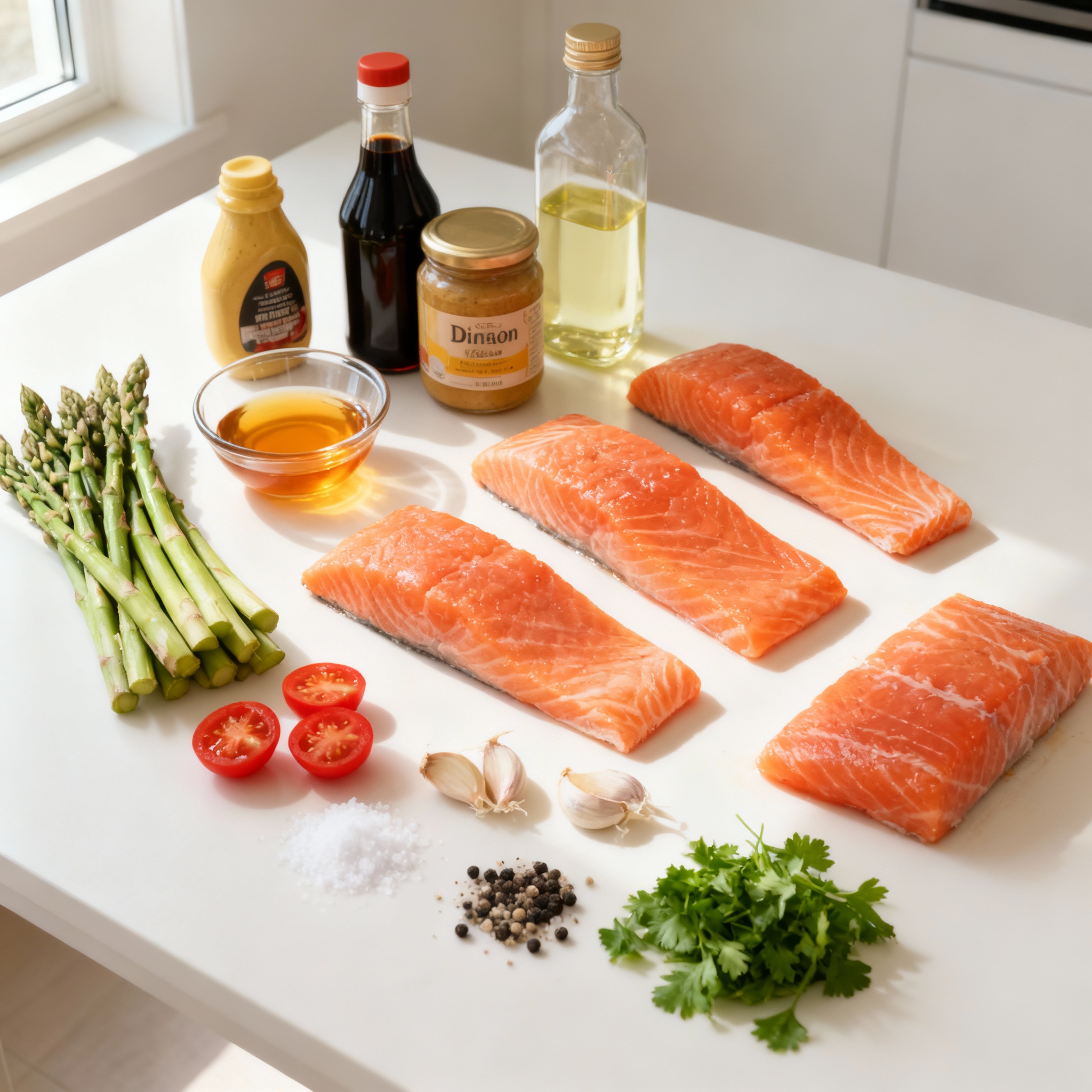
Step-by-Step Instructions
Prepping the Oven and Ingredients
First, I set my oven to 400°F (200°C). This heat gives the salmon a nice cook. While it heats, I gather all my ingredients. I measure out ¼ cup of pure maple syrup, 2 tablespoons of soy sauce, and 1 tablespoon of Dijon mustard. I also grab 1 tablespoon of olive oil. Next, I rinse 4 salmon fillets and place them on a baking sheet lined with parchment paper. I season them with salt and pepper.
Making the Maple Glaze
In a small bowl, I whisk together the maple syrup, soy sauce, Dijon mustard, and olive oil. I make sure to blend them well. The glaze smells sweet and tangy. I save half of this glaze for later. This way, I can drizzle it over the dish before serving.
Cooking the Salmon and Veggies
Now, I prepare the veggies. In a separate bowl, I toss 2 cups of trimmed asparagus and 2 cups of halved cherry tomatoes with 2 minced garlic cloves, salt, and pepper. I spread these veggies around the salmon on the baking sheet. I then brush each salmon fillet with the maple glaze.
Once everything is on the baking sheet, I place it in the oven. I bake for about 12-15 minutes. I check for doneness by seeing if the salmon flakes easily with a fork. The veggies should look bright and tender. For a nice finish, I can broil the salmon and veggies for 2 minutes at the end. This adds a lovely caramelized look. Finally, I drizzle the reserved glaze over the salmon and veggies and garnish with fresh chopped parsley.
Pro Tips
- Perfectly Cooked Salmon: To ensure your salmon is perfectly cooked, use a fork to check if it flakes easily. It should have an internal temperature of 145°F (63°C).
- Enhance the Flavor: Marinate the salmon in the maple glaze for 30 minutes before cooking to deepen the flavor profile.
- Vibrant Veggies: For the best texture and color, avoid overcooking the asparagus and tomatoes. They should remain bright and slightly crisp.
- Garnish Wisely: Fresh herbs like parsley not only add color but also enhance the dish's flavor. Consider adding a squeeze of lemon for brightness.
Tips & Tricks
Best Practices for Salmon Cooking
To cook salmon perfectly, start with fresh fillets. Look for bright, moist flesh. The fillets should smell like the sea, not fishy. Preheat your oven to 400°F (200°C) for even cooking. Season the salmon with salt and pepper before applying the glaze. This will add a nice touch to the final flavor. Brush the salmon with the maple glaze generously. Bake it for 12 to 15 minutes. The salmon is done when it flakes easily with a fork. If you want a caramelized finish, broil it for the last two minutes.
How to Choose Fresh Vegetables
Fresh vegetables make a big difference in taste. For asparagus, look for bright green stalks. They should be firm, not limp. When choosing cherry tomatoes, pick ones that are shiny and firm. Avoid any with wrinkles or dark spots. Always buy seasonal veggies for the best flavor. This dish uses asparagus and cherry tomatoes, but feel free to mix in other fresh veggies you enjoy. Washing them before cooking keeps them clean and crisp.
Enhancing Flavor with Herbs and Spices
Herbs and spices can elevate your dish. Fresh parsley adds a pop of color and flavor. You can also try dill or basil for a different twist. Garlic is a must in this recipe, giving it depth. If you like heat, add a pinch of red pepper flakes. Remember to taste your glaze before cooking. Adjust sweetness or saltiness to match your preference. Simple tweaks, like adding lemon zest, can brighten the dish.
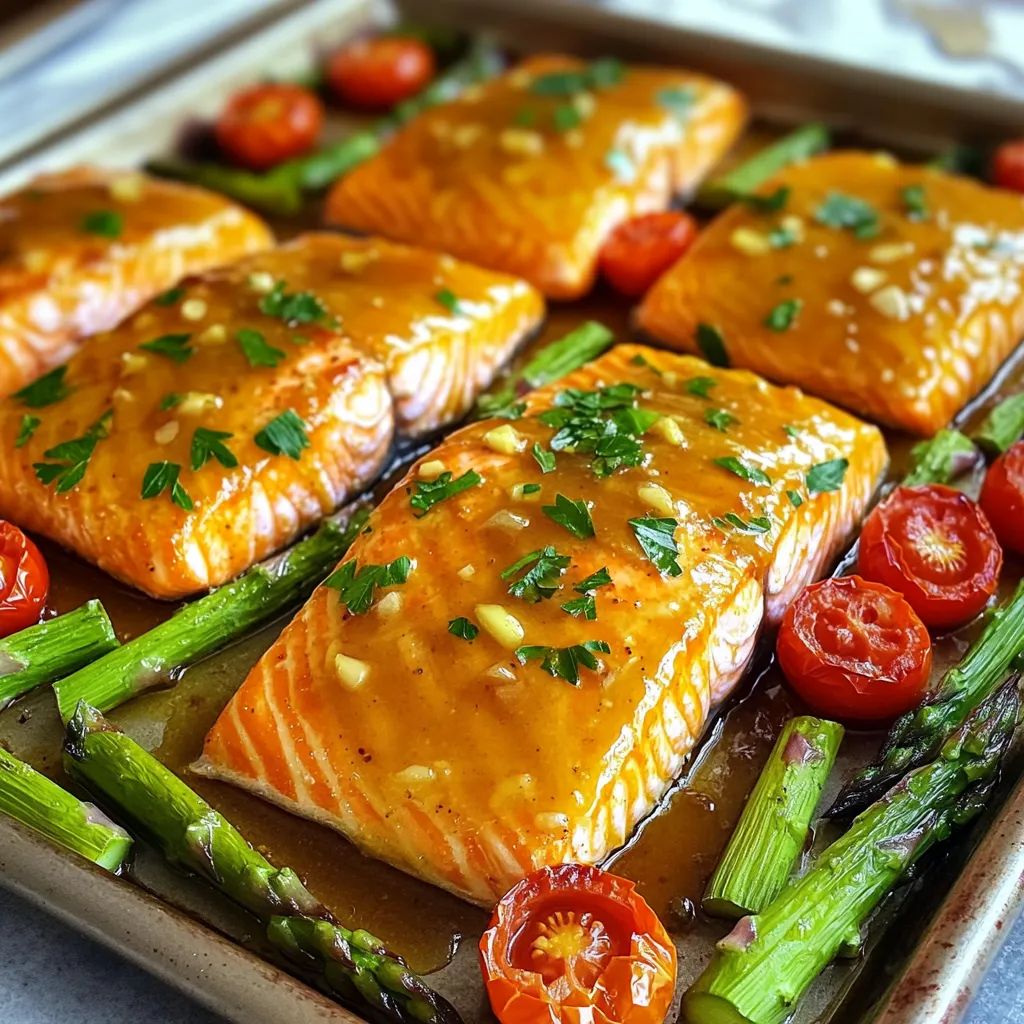
Variations
Maple Glazed Chicken or Tofu Options
You can swap salmon for chicken or tofu. For chicken, use boneless, skinless breasts. The cooking time may change to about 20-25 minutes. For tofu, use firm or extra-firm types. Cut them into thick slices and marinate them in the glaze for about 15 minutes before cooking. The sweet glaze works well with both options, giving a rich flavor.
Alternative Vegetables to Use
Feel free to change the veggies. Broccoli, bell peppers, and zucchini work great. You can also try green beans or snap peas. Just remember to keep the cooking times similar. Each choice brings a unique taste and texture to the dish.
Incorporating Citrus for Added Flavor
Adding citrus can brighten the dish. Try squeezing fresh lemon or lime juice over the salmon and veggies. You can also add orange zest to the glaze. This extra layer of flavor pairs well with maple syrup. It makes the dish even more refreshing and delicious.
Storage Info
How to Store Leftovers
After your meal, let the salmon and veggies cool first. Place leftovers in an airtight container. You can keep them in the fridge for up to three days. Make sure to store the glaze separately if you have any left. This helps keep everything fresh.
Reheating Instructions
To reheat, preheat your oven to 350°F (175°C). Place the salmon and veggies on a baking sheet. Cover them with foil to avoid drying out. Heat for about 10-12 minutes. If you like it crispy, you can broil them for the last two minutes. Always check the center to ensure it’s warm.
Freezing Tips for Meal Prep
If you want to freeze your leftovers, make sure they are completely cool. Wrap the salmon and veggies tightly in plastic wrap. Then, place them in a freezer-safe bag or container. They can last up to three months in the freezer. When you are ready to eat, thaw them in the fridge overnight before reheating.
FAQs
Can I use salmon fillets with skin?
Yes, you can use salmon fillets with skin. The skin helps keep the fish moist and adds flavor. Cooking with the skin on can also make it easier to handle the fillets. When ready to serve, you can simply remove the skin if you prefer.
What can I serve with maple glazed salmon?
Maple glazed salmon pairs well with many sides. Here are some great options:
- Rice or quinoa for a hearty base.
- Mashed potatoes or sweet potatoes for creaminess.
- Fresh salad with greens and a light dressing.
- Roasted or steamed vegetables like broccoli or carrots add color and nutrition.
How do I know when the salmon is done cooking?
The salmon is done when it flakes easily with a fork. You can also check the internal temperature. It should reach 145°F (63°C). The flesh should look opaque and have a nice pink color. If you see this, it’s ready to enjoy!
Cooking with the right ingredients is key to tasty meals. I shared steps to make maple-glazed salmon, including prep, glaze, and cooking techniques. Use fresh veggies and herbs to enhance flavors. You can also try variations with chicken or tofu. Store your leftovers well for quick meals later. For any questions, like how to tell when your salmon is done, refer to the FAQs. Enjoy your cooking journey and share your results!
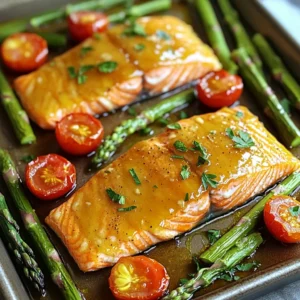
Maple Glazed Salmon & Veggies
Ingredients
- 4 fillets salmon (about 6 oz each)
- 0.25 cup pure maple syrup
- 2 tablespoons soy sauce
- 1 tablespoon Dijon mustard
- 1 tablespoon olive oil
- 2 cups asparagus, trimmed
- 2 cups cherry tomatoes, halved
- 2 cloves garlic, minced
- to taste salt and pepper
- for garnish fresh parsley, chopped
Instructions
- Preheat your oven to 400°F (200°C).
- In a small bowl, whisk together the maple syrup, soy sauce, Dijon mustard, and olive oil until well combined. Set half of the glaze aside for serving.
- Place the salmon fillets on a baking sheet lined with parchment paper. Season them with salt and pepper. Brush each fillet generously with the maple glaze mixture.
- In a separate bowl, toss the asparagus and cherry tomatoes with minced garlic, salt, and pepper. Arrange the veggies around the salmon on the baking sheet.
- Place the baking sheet in the preheated oven and bake for about 12-15 minutes, or until the salmon is cooked through and flakes easily with a fork. The veggies should be tender but still vibrant in color.
- For extra caramelization, you can broil the salmon and veggies on high for the last 2 minutes of cooking time.
- Drizzle the reserved maple glaze over the salmon and veggies before serving. Garnish with fresh chopped parsley.

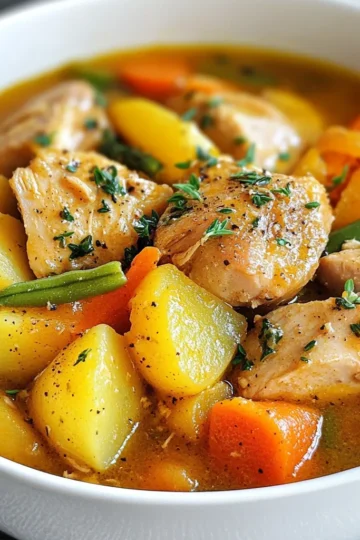
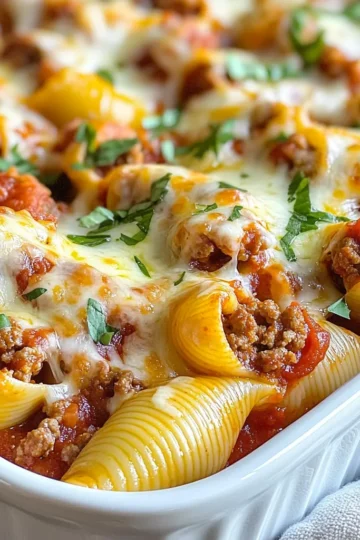
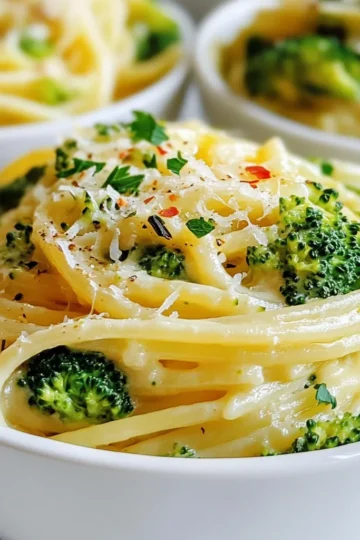
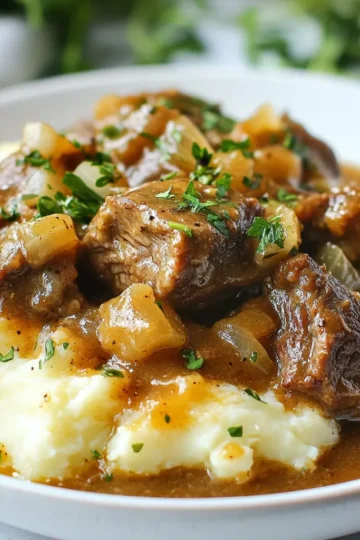
Leave a Reply